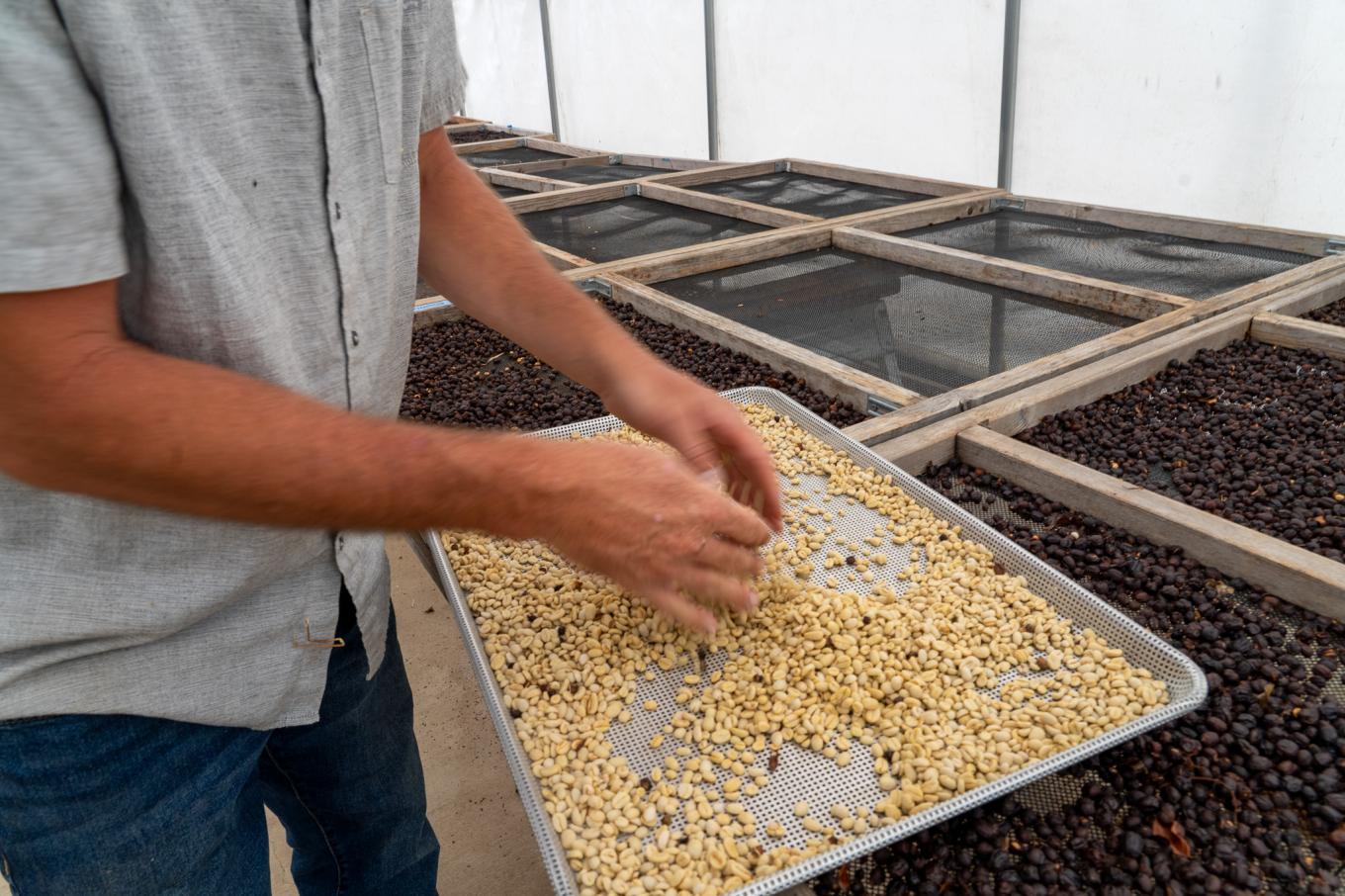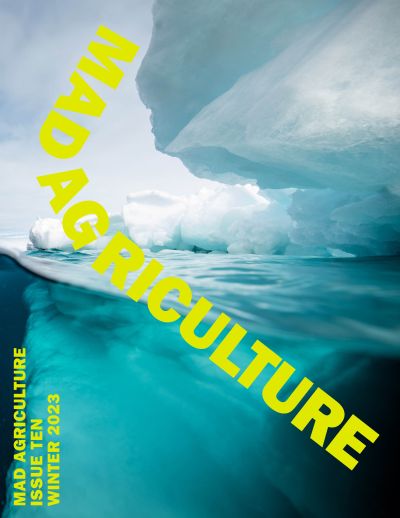
The Mad Agriculture Journal
Farming in Three Dimensions
Published on
December 13, 2023
Written by
JONNAH PERKINS
“I see systems. That’s why I like surfing. Surfing has all these moving dynamics: reefs, currents, wind, waves, people.” This is the answer I got when I asked farmer and agricultural innovator, Jay Ruskey, what makes him a good farmer. As we drove in his truck up the 101 highway from Ventura, California, visiting one of his network farmers, back to his farm north of Santa Barbara, Jay recounted his entry point into farming. He motioned out to the ocean just as much as he pointed out farming operations that fan up the coastal mountains. “When you ride a good wave, you’re like, I just mastered that dynamic system. And what we do in farming is optimize our dynamics. From day to day, hour to hour, and year to year, it’s a dynamic system.”
Jay has been attracted to complex systems from childhood. Coming from an entrepreneurial family, Jay was exposed early on to both improving existing industries and creating new ones. From cut flowers to direct-to-consumer rare fruit production to a ten year project of bringing the caviar finger lime to market to developing rice straw structural insulated building blocks, Jay’s energy for doing things in a new way eventually led him to his current innovation: coffee.
20 years ago, as an experiment in orchard biodiversity, Jay planted coffee trees alongside avocados on his family’s farm, Good Land Organics, in the foothills of the Los Padres Mountains, in Goleta, California. Like any perennial system, the answers to the question of whether or not coffee would thrive in this ecosystem would require patience. While his avocado trees shared water and provided windbreak for the young coffee plants, the seed of coffee innovation was planted in Jay’s mind. With a three to four year waiting period until a coffee tree bears first fruit, and two additional years until the tree puts out a viable harvest, Jay’s farmerly patience was rewarded with a surprisingly sweet coffee cherry, the fruit that contains the coffee “bean”. Jay co-founded Frinj Coffee in 2017 as a vertically integrated system of coffee cultivars, farmer training, fermenting, roasting, and distribution model.
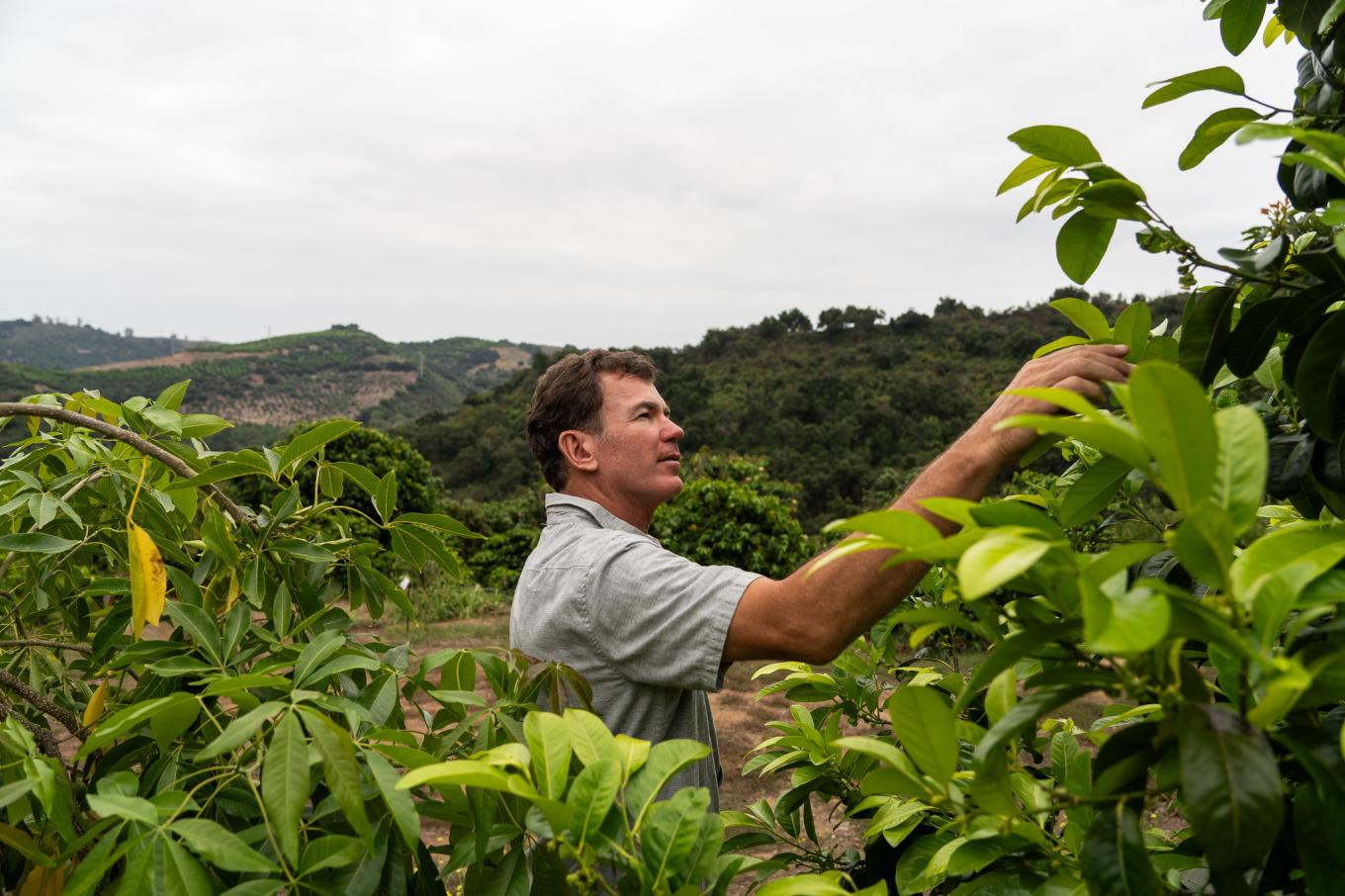
Reimagining Coffee Production
Coffee is traditionally grown in the equatorial belt between the Tropic of Capricorn and the Tropic of Cancer, at 2,500 and 5,000 feet of elevation in humid mountain forest ecosystems. As the global demand for coffee increases the health of the industry’s trees is diminishing. Many of the world’s coffee trees are over 30 years old and increasingly vulnerable to pathogens while also experiencing pressures of climate variability.
“Coffee itself is so far behind in plant development as an industry. It’s too late for a lot of the farms that need to adjust not only for climate change, but also the markets. A lot of coffee companies are doing fancy ferments on beans to modify coffee taste from the traditional flavors profiles,” said Jay. Much of the global coffee growing regions are being impacted by coffee berry borer and coffee rust (roja), two major pathogens that are devastating trees coming from breeding stock that was developed in the 1950’s. “The coffee industry needs plant research to bring the crop into the future climate to support the growing conditions it’s facing,” Jay told me as he squatted down next to a young coffee plant and scanned a QR code on a tag attached to a branch. “This is one of the most tracked farms on the planet – with coffee specifically. Every single tree on this farm has a unique code. Frinj has invested in a breeding program, so every plant has the ability to produce a potential desired and improved outcome. Or traits of a male-female that creates a hybrid.”
I asked Jay what a potential desired outcome would be given the more extreme temperature fluctuations in the Mediterranean climate of Southern California compared to mountain jungle conditions, “We’ve been selecting for cup quality, high yield, and frost tolerance. If you’re growing corn or tomatoes, for example, you have a whole list of hybrids to help put yourself into a different market or be more adaptable to the soil, water, and climate conditions that you’re growing within, but not with coffee. So we are creating that data right here.” With coffee research, Jay and his team are not only pushing the coffee tree into new growing zones but combining modern technology with a holistic business approach.
Frinj now has over 65 growers in production from San Diego to Santa Barbara. The Frinj model is built around the concept that coffee can and should improve the ecosystem in which it’s grown in an agroforestry framework. Multi-generational planning is necessary not only for the productivity of the tree crop but also for the reality of what the soil can support.
“Solely growing coffee continuously for over two decades on the same piece of land can be part of the problem or part of the solution depending on the growing technique,” Jay told me in an email prior to my visit. “We firmly believe that in the era of the Anthropocene, agriculture needs to collaborate with succession and work to positively regenerate collapsing ecosystems into vibrant novel ecosystems. Coffee can be grown using organic and regenerative agroforestry techniques that apply agroecological intelligence to achieve a holistic host of land use goals.”

Perennialism as a Way of Experiencing Time
“In the first few years of this company we put a lot of resources toward the breeding program. To make a coffee tree can take a decade. But it’s something that’s necessary for the industry,” Jay told me as we walked down the switchback roads between terraced levels of orchards that descend from Good Land Organics and Frinj packing houses. “If you’re connected to the land with some level of permanence, you know that cycles will constantly be changing. For perennial crop agriculture you have to have a 20 year window.”
In his evolution of diversified agroforestry production theory, I stood with Jay in material stratified bands of time. Looking uphill I was seeing Jay’s theories from the past flowing in sequential order toward us. The density of the canopy and variability of biodiversity cascaded down toward my feet. Like a writer flipping pages of a notebook back to the beginning, Jay’s farm is a living record of his orcharding learning process.
Through rigorous methodology of coffee development balanced with the demands of moving through the market as an entrepreneur, Jay is constantly leaning into his intuition of reading dynamic systems. He is also reconciling the reality of the scales of time he is operating within, “If you cut corners in year one and two, you’ll suffer in year ten. It’s hard to explain this to new farmers who can’t think that far ahead. That’s why not everyone is a perennial tree farmer,” Jay said when I asked him about how he communicates the perennial mindset to people who don’t live within it. Decisions made by a young farmer will continue unfolding on a decade by decade scale. Orchards are perennial systems which means they develop over generations. The planting of an orchard is either a gift or a burden to the future version of a farmer’s life.
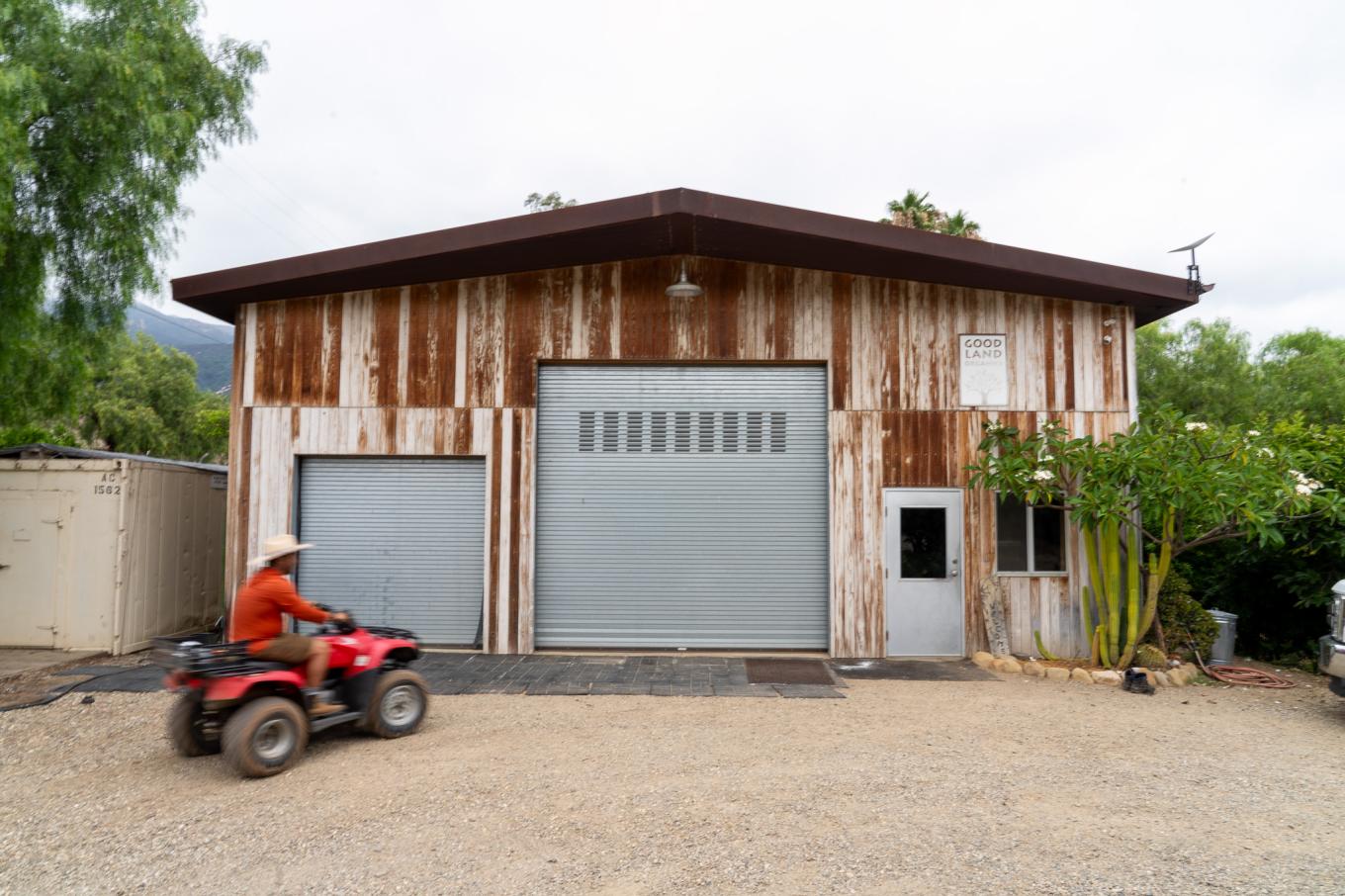
Three Dimensional Farming
In agriculture we talk about acres, and in livestock systems we might even talk about carrying capacity. Jay introduced me to an entirely new way of seeing a landscape which is three dimensionality, to quantify the production potential of the land.
“Years ago we got into a water restricted time. I started looking at farming more in cubic meters and cubic spaces,” Jay said. This change in mindset inspired Jay to begin with interplanting to create windbreaks and canopies. “We found efficiencies in labor. Avocados got better. The coffee was better protected from wind and other elements that come in California. Overall, we look at a more productive state of being per acre or per cubic area,” Jay said about the benefits of multi-layered companion crops together.
Jay showed me an example of coffee thriving in a controlled 3D design, “This is how the geisha coffee variety likes to grow: leaf litter on the ground, companion crops of avocado and inga tree (ice cream bean), wind protection from Casuarina trees. It’s such a cool symbiotic ecosystem.”
Three dimensionality also brings in agility and financial resilience if there is a down year for a crop or if the market value of crops experience fluctuation. Jay went on to say, “It actually reduces the risk to the farmer by having multi-crops not only from dealing with the risks in the market changes, but also in creating a resilient system of farming to deal with the windier conditions that we get through a La Nina year or hail.”
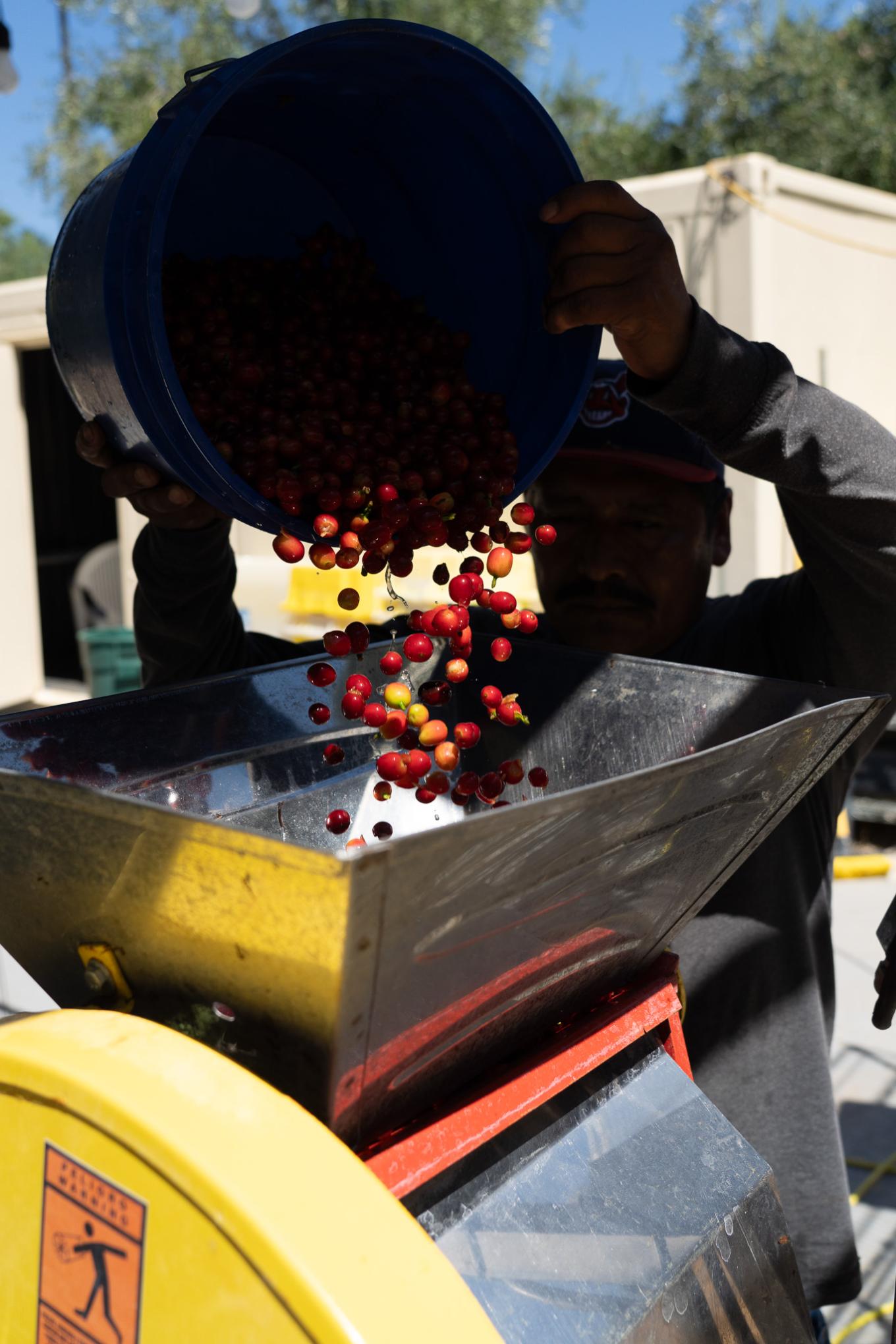
Water
“Geologically speaking, California is super unique because it has ways to store water. That’s what water rights are built on, storage and distribution from snowpack, rivers, and aquifers. Our farm has rights to a large 350,000 acre foot reservoir, which we have gravity fed to us through a mountain,” Jay told me as he pointed inland and upward. A significant departure in how coffee must be grown in California compared to traditional equatorial coffee growing regions is irrigation. The water issue is one of the largest criticisms of California-grown coffee, and for good reason. Water scarcity and water access is a growing challenge for the entire state. Water is one of the primary factors in Jay’s three dimensional design and his strategy is created to be as efficient as possible.
“It’s crazy how much water wheeling is done in this state and how people have been pretty innovative on how they get their water. That’s why our layered system of farming more densely – layering in and protecting from wind while building soils that can hold water and nutrition – is so important,” Jay explains about how his agricultural approach stretches the water that is being utilized. “When water gets scarce it then becomes a water quality issue. Before a drought, water quality drops. The salts will kill the plants before they actually run out of water or become unproductive. You have to be quite a bit of a water chemist to grow anything in California.”
Unlike monocropping systems where water is allocated to a single crop that takes in water at a similar rate, Jay’s design stacks natural systems that ebb and flow with one another while building soil carbon. “From the practical sense, we look at how we can increase water holding capacities of soils, which usually is related to organic matter. Now that we have high spectrum testing, we can see what are the beneficial microorganisms that are changing in the soil. We can also get a look at the carbon sequestration. Every day it’s more carbon talk. As we know, perennial crops do a good job of sinking the carbon in the soil.”
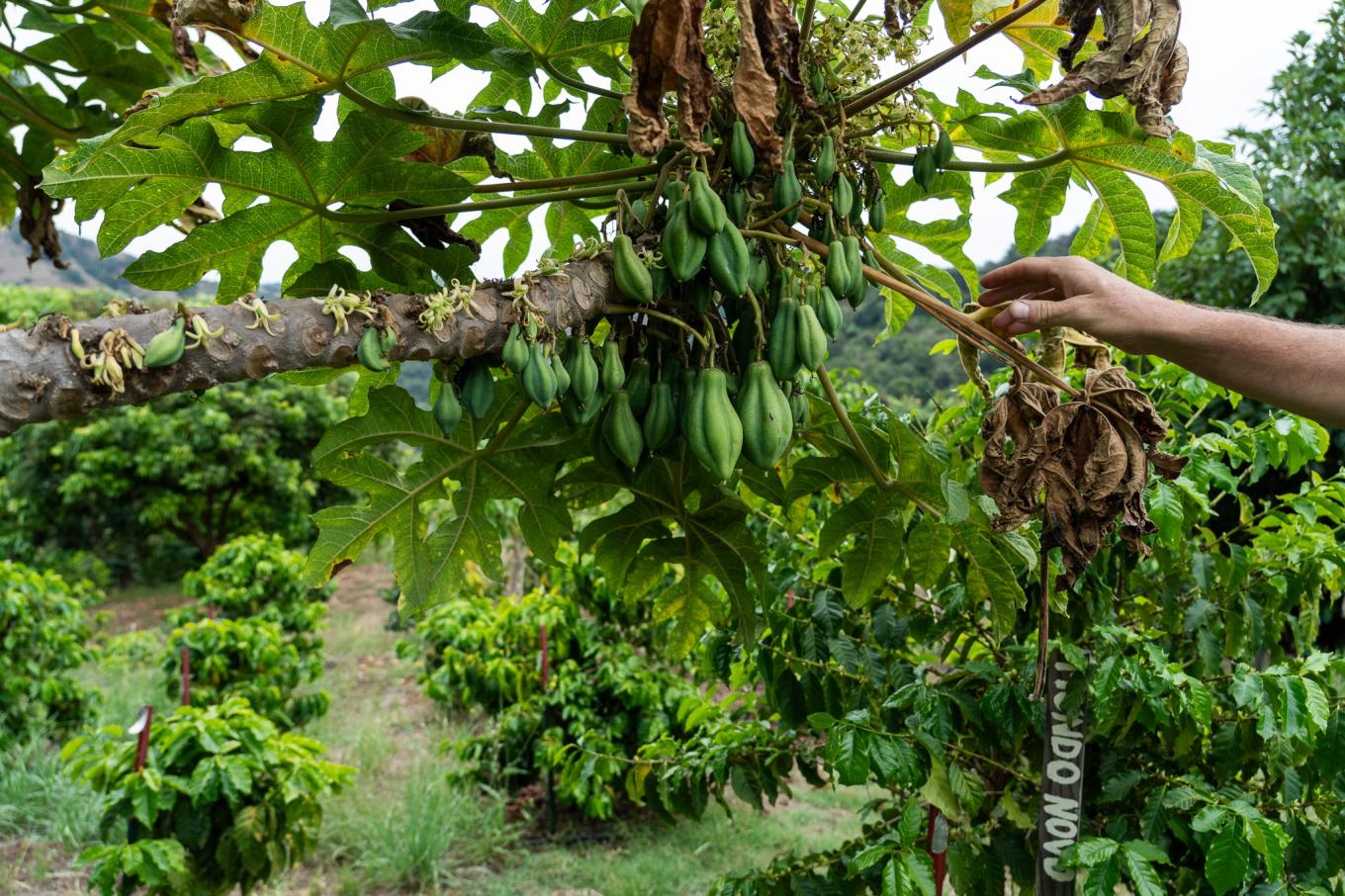
Firefighter / Farmer
“If you want to be a farmer in Southern California, you’ve got to have a fire fighter mentality. That’s what it comes down to. It’s a very interesting complexity of the farms in Southern California. Fire is part of our landscape,” Jay had told me over the phone when I was planning this trip. Just two weeks before my visit to Jay’s farm, I had seen wildfire in the news and wanted to be sure he wasn’t being impacted.
Wildfire remains the largest existential threat to farmers in the coastal mountain region of Southern California. The chaparral oak scrub ecosystem historically has experienced natural burning events every few decades. But with growing climate variability and land development, Southern California has seen back-to-back years with increasingly severe fires.
“Farmers really know their land better than anyone,” Jay told me as he pointed up into the Los Padres Mountains rising up steeply behind his farm. With agricultural production stretching up from the ocean into the foothills, the deepest knowledge within the landscape and the infractricture lies with those who are stewarding the terrain.
“I was part of an emerging program that trains farmers to be certified to assist in emergency fires activities through what is called an Ag Pass. Each canyon in Santa Barbara County generally has a designated farmer,” Jay told me as we passed farm and residential driveways on our way downhill. “I am the designated farmer of these two canyons,” he said, gesturing to the landscape that was folding onto itself in waves of golden grass. “So that means I have a special pass to assist in accessing roads, evacuating animals, opening gates, and advising on the topography. Now about half of the counties in California are adopting the program that I helped to start here in Santa Barbara County.”
“We’re in the front lines of it all. Fires get locked up in here so there can be sometimes ten days of threat of fire coming down on us. The winds can really kick the fires up so we get prolonged evacuation periods and intense fire equipment and personnel coming in and out. On these roads we get Class 3 fire engines and multiple dozers for fireline work, which is work that I am involved in,” Jay told me as we descended the steep gravel road from his farm down to the 101 Highway. Fireline line work includes taking bulldozer blades and trenching lines on ridge tops to stop the progression through a combination of clearing, fire retardant, and laying water hoses on the fire. “You want to let the material burn behind it then when it hits the line it doesn’t jump. Using fire to fight fire.” He pointed out of my window showing me the path that the most recent fire took. I saw steep fire roads serpentining across the mountains before disappearing over the ridgetops and imagined fire slashing across the landscape.
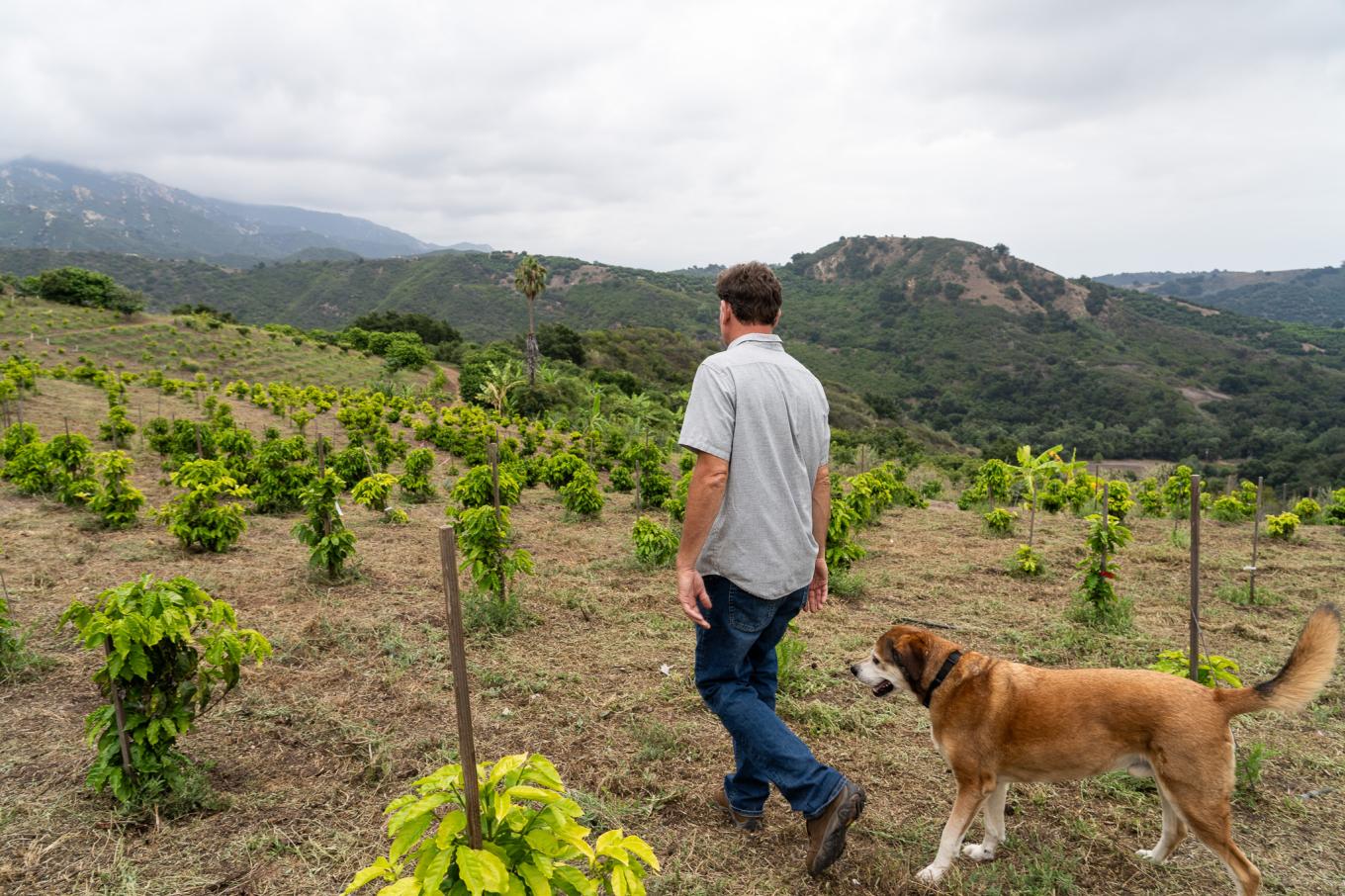
The Question of Scalability
On my last day on Jay’s farm, as I packed up my cameras and had one last cup of coffee, I asked Jay the main question that had been building in me: does he think these dynamic 3D systems will work at scale. His response: “That is something I have been wrestling with for years. I think there is a way in which we can do it but it has to be well designed and managed.” Jay’s ability to hold the learnings from the past while working into the future, requires holding multiple timescapes at once. Perennialism is an exercise in observation, trust, and taking big swings, or big waves.
